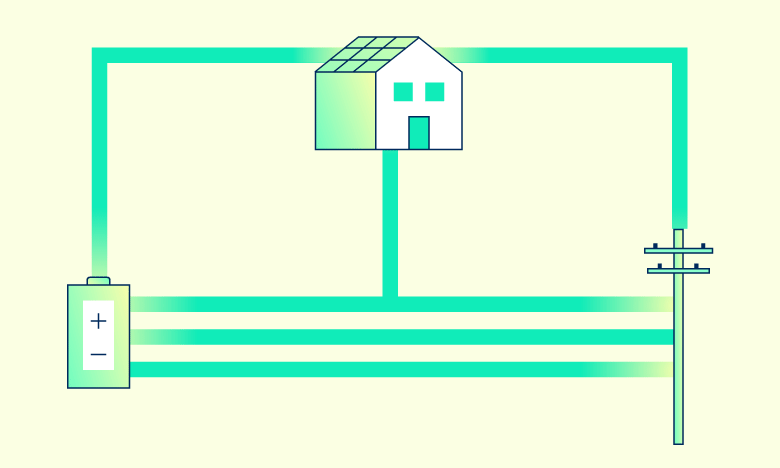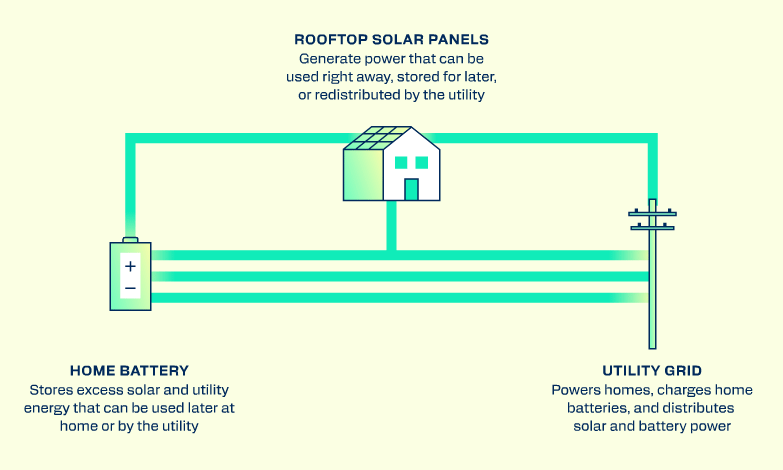
Imagine your home not just consuming electricity, but actively supplying it when it’s needed most. That’s exactly what’s possible with modern home battery technology — a shift that’s empowering households to become important players in the electricity market.
The power grid is undergoing one of the fastest transformations in its history. Policy changes, new tariffs, rising interest rates, and climate-driven peak demands are reshaping the way we produce, store, and use energy. Meanwhile, millions of homes equipped with solar are discovering the next logical step: adding battery storage. Batteries are the missing link that can make solar power work around the clock, giving you independence while helping stabilize the grid.
Let’s explore how these systems work, understand the benefits they offer, and see why their role in our energy future is becoming more important than ever.
What is a home battery system and how does it work?
A home battery system is essentially a rechargeable energy storage unit designed for residential use. Underneath the sleek casing, a battery system contains several core components:
- Battery cells: stores the electricity for future use
- Battery management system (BMS): ensures safe and efficient operation
- Inverter: converts stored DC energy into AC power that your home can use
- Safety disconnects: protect the system from electrical faults
- Smart monitoring software: provides real-time insights into charge levels, energy usage patterns, and long-term performance
There are two leading battery chemistries in home energy today:
- NMC (Nickel Manganese Cobalt) batteries offer high energy density (meaning they can store a lot of power in a smaller space) and are used in popular systems like the Tesla Powerwall 1 and 2 and the SolarEdge Energy Bank Battery.
- LFP (Lithium Iron Phosphate) batteries provide a longer cycle life and stronger thermal stability — excellent for households seeking durability and stability, as seen in products like the Tesla Powerwall 3, Enphase IQ and FranklinWH aPower.
Why battery chemistry matters
The battery’s chemistry determines its lifespan, efficiency, and safety. NMC batteries can store more power in less space, while LFP batteries generally last longer and have lower risk of overheating. Understanding these trade-offs will help you select a system that aligns with your goals — whether that’s maximizing backup capacity, achieving decades-long reliability, or ensuring the safest possible installation for your home.
AC-coupled systems vs DC-coupled systems
Two main system configurations are available:
- AC-coupled systems work well for retrofits, using a dedicated inverter for both the solar panels and the battery.
- DC-coupled systems are more efficient but are typically installed alongside solar from the start, integrating the battery into the single inverter setup.
System type affects how easily your battery integrates with solar, its scalability, and how well it meets your goals for backup power, energy cost savings, or grid support. It also shapes upfront cost, installation complexity, and long-term operating expenses.
Finally, capacity planning is key. Batteries are rated by energy storage in kilowatt-hours (kWh) — for example, 13.5 kWh might run essential appliances for a full day — and output power in kilowatts (kW), which determines how many devices you can run at once.
“The most important thing to know is that a home battery isn’t just about backup power,” says Ella Wynn Roseman, Head of Battery at EnergyHub, “it’s about taking control of your energy, becoming part of the grid, earning for the power you share, and helping your community stay resilient.”
Achieving energy independence with solar and batteries
The limitations of standalone solar
Solar panels generate clean energy during daylight. And because peak solar production usually happens midday, it doesn’t always match household demand, which tends to surge in the mornings and evenings.
Additionally, the flow stops during outages. For safety reasons, they must shut down to protect utility crews working on the lines.
How batteries boost value
Wynn Roseman highlights that the US is seeing more homeowners invest in batteries than ever before, and not just for backup during outages. Home battery owners are looking for real savings on their electric bills, to take advantage of new incentives, and ways to live more sustainably.
Batteries are a practical tool for energy independence, peace of mind, and reducing environmental impact. They store excess solar energy for use at night, during high-rate periods, or during outages. They also allow you to schedule energy usage strategically, so you’re drawing from stored solar when electricity prices are highest. This functionality transforms your solar investment into a dependable source of power whenever you need it.
For homeowners who already have solar
Adding a battery later is possible but generally more expensive than installing it alongside solar from the start, due to added wiring and equipment needs. Still, many solar owners are retrofitting now to increase resilience as the grid faces more pressure.
How solar battery storage supports and strengthens the power grid
Wynn Roseman explains that while solar power is a valuable step towards clean energy, it truly reaches its full potential when paired with battery storage. A battery doesn’t just store excess solar energy — it supercharges your system. On its own, solar can’t provide resilience during outages because panels shut down when the grid goes down. With a battery, your home keeps running, even in a blackout. It also gives you the freedom to choose when you use your stored energy, whether it’s at night, during peak rates, or in an emergency.
Wynn Roseman emphasizes that when solar and storage work together, the combined strength delivers major benefits for households and communities — from stabilizing the grid to lowering system-wide costs — all while creating a more resilient energy future.
Flattening the load
One of the many benefits of home battery systems that Wynn Roseman explains is the ability to flatten electricity demand at every level — from entire neighborhoods all the way down to a single lightbulb. Now, with batteries available in so many sizes and forms, we can smooth out energy use locally in ways no other technology can.
One of the biggest challenges for utilities is managing the sharp spikes in electricity demand that happen in the mornings and evenings. Without batteries, these peaks often require the use of expensive “peaker” plants, which sit idle most of the time but cost far more to operate. These costs are passed onto the consumers, making energy bills more expensive and generating more CO2 emissions. When homes have battery storage, they can discharge stored energy during these high-demand hours, helping spread out or “flatten” the load. The more households that join in, the more the strain on the grid eases across entire neighborhoods and regions, and the less that peaker plants have to be deployed.
Reducing transmission stress
Another less-visible advantage of local battery storage is its impact on transmission lines. When electricity doesn’t need to travel long distances at maximum capacity, it reduces wear on infrastructure and delays costly upgrades to poles, wires, and substations. Instead of relying solely on centralized power plants, communities can provide more of their own energy locally, keeping the grid healthier and more efficient, while making energy more affordable for all customers.
Lowering system-wide costs
This localized production and storage doesn’t just improve reliability — it can directly lower the price of electricity for everyone. Take New England as an example: in one week during the summer of 2018, distributed solar reduced wholesale electricity prices by nearly 15%, saving $20 million during a heat wave. Batteries can amplify this type of savings by shifting solar energy from low-demand periods to the high-demand hours when electricity is most expensive to generate. It’s a win-win for households and the grid.
Supporting local resilience
Home batteries paired with solar do more than protect individual households. They help communities stay powered when the grid experiences outages by storing energy locally to keep essential appliances running, maintain communications, and provide backup for vulnerable residents. When many homes in a neighborhood have batteries, they can be connected into microgrids, localized networks that share stored energy, stabilize demand, and operate independently if there is a grid outage.
On a larger scale, commercial battery systems installed near critical facilities such as hospitals, emergency shelters, schools, and community centers act as anchors for bigger microgrids. These systems store renewable energy during normal operation and deliver it instantly during emergencies, safeguarding medical services, refrigeration, and emergency coordination centers.
Whether powering a single home or a network of vital facilities, batteries integrated into microgrids transform backup storage into active resilience infrastructure. This reduces strain on utilities, lowers carbon emissions, and keeps communities operating even when there is a grid outage.
“You can be a mini power plant and take your energy needs into your own hands.”
Ella Wynn Roseman - Head of Battery at EnergyHub
Why electric utilities value home battery storage systems
As part of a virtual power plant (VPP)
Utilities are now aggregating home batteries to create virtual power plants — massive, distributed resources that can be managed like a single energy asset.
Paying for value
Homeowners can earn bill credits or payments from utilities by participating in demand response programs or allowing stored energy exports during peak demand periods.
Improved reliability
During grid stress events, batteries deliver rapid-response reserves that help prevent blackouts on a neighborhood or regional scale.
The future of home solar batteries and renewable energy storage
Looking ahead, batteries are becoming central to whole-home electrification, integrating seamlessly with EV chargers, heat pumps, and smart home controls to create a fully connected, efficient energy ecosystem. These advances aren’t happening in isolation — they’re being shaped by evolving policies and market trends. Tax credit phase-outs could make early adoption more financially advantageous, while supply chain diversification may help stabilize costs long-term.
Those who act early stand to benefit the most, securing incentives while gaining valuable operational experience that maximizes savings and optimizes system performance. Every battery installed brings personal advantages, including independence, resilience, and cost control, while also delivering public benefits by making the grid more stable, flexible, and affordable.
To learn how your home can contribute, explore local demand response programs and join the growing community of homeowners driving towards cleaner, more reliable power.
Want to learn more how to purchase a home battery system? Check out our second blog in our Battery 101 series.
